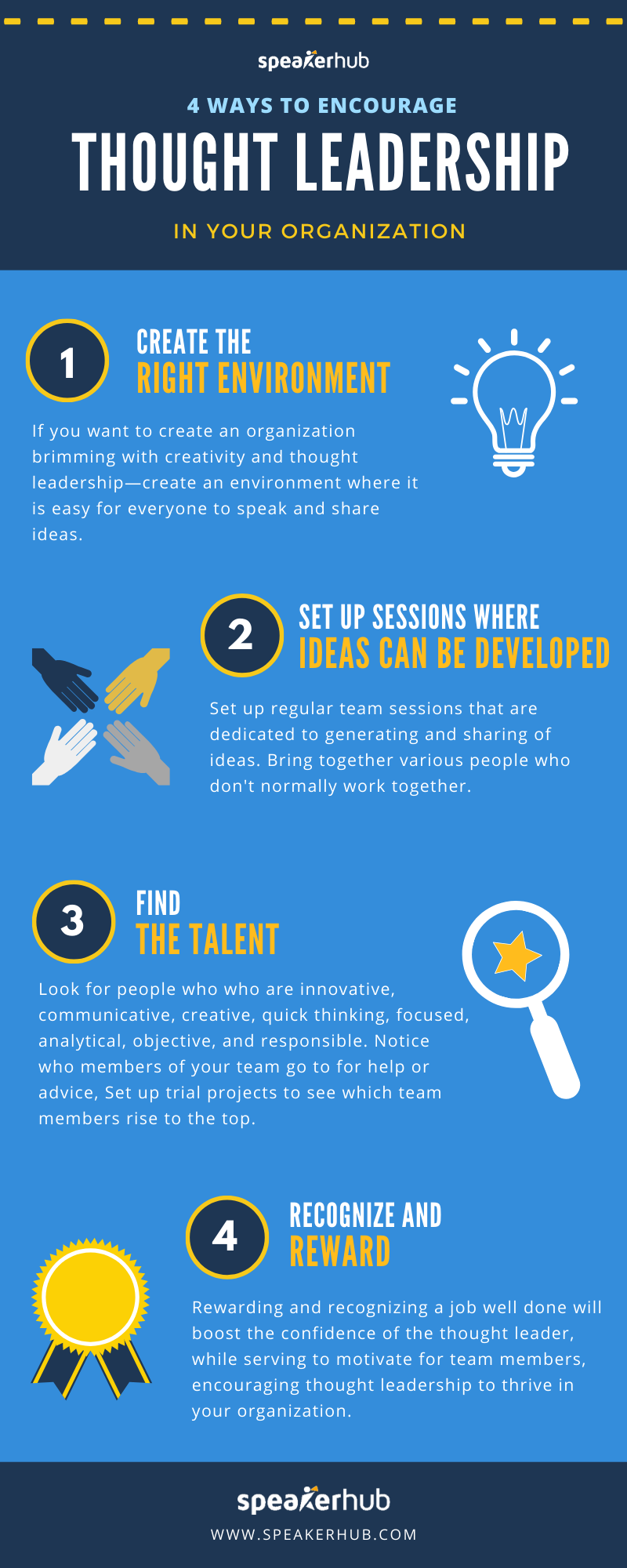4 ways to encourage thought leadership in your organization

The Oxford dictionary defines thought leadership as “intellectual influence and innovative or pioneering thinking.”
The term has been around since the 19th century, but in the past ten years “thought leader” has become a buzzword used to describe experts who know the ins and outs of their industry, and can come up with innovative ideas to cater to the demands and needs of their audience.
Organizations that can cultivate thought leadership from within their teams have a strategic advantage when it comes to growth in market leadership, product and service development, accountability, and client engagement.
How can thought leaders impact your organization?
The best, most innovative ideas don’t always always come from the top.
The individuals who are on the ground floor—working with clients, operating the day-to-day, building products or services, have a very different perspective on the organization, which can be very valuable.
Nearly any team member will be able to pin-point issues and problems, but an environment where thought leadership is encouraged will help your organization find innovative solutions instead of just a myriad of issues.
In an organization where thought leadership is not encouraged, issues are commonly known by the team, but there is no incentive to come up with solutions or try to impact change — employees feel they are just there to do their job, and they make changes only if and when the ideas come down from the top.
By encouraging thought leadership, the team feels empowered to offer solutions and make positive changes within the organization.
This can not only impact the efficacy of the organization but positively position it as an industry leader.
The most straightforward way to encourage team members to stretch their thought leading muscles is to make it very clear that their ideas are not only wanted but needed, implement the ideas regularly and on a timely basis, and reward team members who show initiative.
There will always be some team member who will shine above the rest, and some who will be less creative and intuitive, but it’s important to remember that using this approach can help you find diamonds in the rough—there are always some team members who rise up and surprise you.
By cracking open communication, and letting creative freedom flourish in your organization, you may find that you’ve had a team of thought leaders behind you the whole time.
So, how do you encourage thought leadership from within your organization?

1. Create the right environment
One of the main obstacles standing in the way of creating an atmosphere where ideas thrive is actually the management.
“[Managers] lament the fact they don't get creative ideas, useful pushback to their own ideas, or meaningful conversation about important issues. The managers usually propose all kinds of negative reasons for this lack of interaction: “They just don’t care.” “They’re risk-averse.” "They’re not creative.”...Almost without exception, in my experience, these things aren't true: the problem lies with the manager. Managers very often act in ways that make it difficult for people to talk in meetings.”
—Erika Andersen (Article “5 Simple Things You Can Do To Get People To Speak Up In Meetings” for Forbes)
When management is too assertive, aggressive or demanding with their teams, individuals have a tendency to clam up and keep their heads down.
This can have a knock-on effect. When new people join the organization, they often pick up on the behaviour of the team around them, meaning you could hire people who have brilliant ideas, but the environment does not encourage them to thrive.
If you want to create an organization brimming with creativity and thought leadership, create an environment where it is easy for everyone to speak up and share ideas.
Inspire them to share
“Pressuring people to share knowledge rather than making them see the value of it doesn’t work very well. If workers do not understand the importance of sharing knowledge to reach unit or organizational goals, they will be less likely to share that knowledge. And if workers are pressured into sharing what they know, it could backfire. If they’re afraid of losing a competitive advantage, they may be even more reluctant to reveal information.”
—“Why Employees Don’t Share Knowledge with Each Other” published by Havard Business Review, 2019
According to research by the Harvard Business Review, team members are more likely to share more when they are able to see the overarching value in contributing.
Chances are that if a team member doesn’t understand why they are being asked to share, feels like you are wasting their time, or doesn’t believe that their ideas will be implemented, it will be a lot more challenging to get them to share ideas.
Rather than pressuring people to share their ideas, make it clear what the value is in them sharing ideas; for the organization, for the team, and for them individually.
Set time apart
Set up a time for idea sharing, and let the team know well in advance that there will be time for discussions on key topics.
This will give them time to pull ideas together, to ruminate, and to get creative.
Demanding instant creativity might not be the best way to glean the best ideas. Especially when starting out with this process, creative ideas often need some time to grow.
Listen and offer tactful feedback
When you are in the meetings, it is important to make sure everyone has a chance to be heard.
Many managers confuse leading a session with talking the entire time, and as a result leave little room for others’ input or ideas.
If you want to encourage creativity, collaboration and thought leadership, you need to give people a platform to share their ideas.
You are going to hear some bad ideas, maybe even some really horrible ones. And this is ok.
And while you want to be honest with your feedback, make sure to keep your feedback tactful. Remember, you are cultivating an idea-sharing culture, which means that those sharing have to feel safe about doing so.
You can be clear about which ideas are good and which are categorically bad, but how you offer feedback can impact the environment you create for your team and influence how safe they feel it is to share ideas.
2. Set up sessions where ideas can be developed
Set up regular team sessions that are dedicated to generating and sharing of ideas. As mentioned above, they can be stand-alone sessions or built into meetings, training sessions, and conferences.
Have a focus point for each session, and let the invited members know what the session is going to be about, how long it will be, and who will be there, well in advance.
Encourage people to loosen up and get comfortable with sharing all their ideas.
Vary the formats
Try different formats, like partnering or grouping team members to focus on one issue, or open up topics to larger group sessions.
Depending on the topic, the sessions can be structured with activities, or they can be run independently by the team members; you step out and let the ideas flow.
For example, say that you are looking for some fresh ideas on an outdated process that your company uses. Ask attendees to perform a SWOT or SLOT analysis on the process before the session. That way they come in with ideas a-blazin’ before the start about what works and what doesn’t. The group can compare and share, and then come up with a new process based on what is effective for the company.
Encourage collaboration
In these sessions, it is important to play around with group sizes and attendees. Having the same group cover the same topic at the same time each week, for the same length of time, has the potential to get stale very quickly.
Vary the size of the groups. Change up who comes to which session to get different mixes. Give different people the chance to lead a group at different times. Set up a time for smaller group or one-on-one breakout discussions.
Sometimes bringing together various people who don’t normally worth together, and shuffling up various teams and topics can result in a plethora of new ideas coming to the table.
3. Find the talent
There are people on your team right now who have the potential to make a significant impact on your organization and your industry, but how do you recognize them? How do you pinpoint exactly who the thought leaders are?
Who has the best ideas?
Providing the space for collaboration and idea-sharing is important because it creates a platform for thought leaders to shine.
There will be some team members who constantly step up, offer fantastic insights, and can see solutions where others do not.
With small to medium-sized teams this will be fairly easy to recognize, but if you have a large team with dozens of people with good ideas, this can get a bit more difficult. You can try recording the best ideas from the sessions, and note who is coming up with good ideas and building on them. Review your notes over time to see which names keep cropping up.
Who do others look to for help?
Another way to spot potential thought leaders is by observing which members of your team others go to for help or advice.
These mentors have expertise and experience, and often innately value the growth of the entire team, which is why they are willing to take the time to help others excel too.
Use trial projects
Being a thought leader requires a particular set of skills, such as innovation, communication, creativity, quick thinking, focus, critical analysis, objectivity, and responsibility. However, discerning if a potential team member has those necessary skills can be surprisingly difficult.
If you have a potential thought-leader from your team, and you would like to see what their skill sets and capabilities are, try using test projects. Give them a chance to shine on various platforms.
Here are some examples:
-
a presentation,
-
a research paper,
-
an article for the organization’s blog,
-
a proposal for a communication strategy.
Testing their abilities shows whether they can deliver real value on their own and with others, while giving them an opportunity to showcase their ideas.
4. Recognition and reward
It is essential to recognize and reward thought leadership in your organization if you want it to thrive.
Recognizing and rewarding your thought leader ensures they will stay motivated to continue giving you their best. Recognition is essential for encouraging a sense of purpose. It affirms their role in the bigger picture for the organization, and that their contributions matter.
How you incentivize depends on factors such as:
-
the needs and desires of your team
-
the impact the idea had overall
-
your industry
-
what budget you have
-
what aligns with your organization.
Not only will the reward and recognition boost the confidence of the thought leader, but it will also serve as a motivation for team members, encouraging thought leadership to thrive in your organization.
Wrapping it up
The most straightforward way to encourage thought leadership within your organization is to create the right environment, give team members room to come and share ideas, recognize when you find a thought leader, and reward them for offering and implementing their ideas.
What have you found works, or doesn’t work, when it comes to thought leadership in your organization? We’d love to feature your advice in a future article. Contact us.







